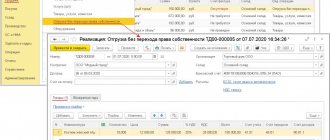In what cases is an employee entitled to an average monthly salary?
The list of situations when payments to an employee are calculated based on the calculation of the average amount of earnings is determined by the Labor Code of the Russian Federation. Among the most common and most often encountered situations in the activities of an ordinary organization that require the calculation of average earnings include:
- payment of vacation pay (Article 114 of the Labor Code of the Russian Federation);
- issuance of compensation for unused vacation - upon dismissal or for part of the vacation over 28 calendar days (Articles 126, 127 of the Labor Code of the Russian Federation);
- employee going on a business trip (Article 167 of the Labor Code of the Russian Federation);
- payment to employees for periods of training while away from work (Articles 173–176, 187 of the Labor Code of the Russian Federation);
- payment of severance pay (Article 178 of the Labor Code of the Russian Federation).
In addition, based on the average monthly salary, the following categories of employees are calculated:
| Employees | Article of the Labor Code of the Russian Federation |
| Those engaged in collective negotiations or preparing a draft collective agreement (agreement) with exemption from their main job. At the same time, the average earnings for such workers can last up to 3 months. | 39 |
| Temporarily transferred to a job other than that provided for in the employment contract | 72.2 |
| Those forced to terminate an employment contract due to non-compliance with the rules for its conclusion (if the violations were not the fault of the employee) - in this case, severance pay is due in the amount of the average monthly salary | 84 |
| Failure to comply with labor standards and labor duties due to the fault of the employer | 155 |
| Forced to remain idle due to the fault of the employer - in such a situation at least 2/3 of the average salary is paid | 157 |
| Members of labor dispute commissions | 171 |
| The manager, his deputy or the chief accountant, dismissed upon change of ownership in the amount of 3 times the average monthly salary | 181 |
| Transferred to lower paid work due to health reasons | 182 |
| Sent for mandatory medical examinations | 185 |
| Employees undergoing medical examination (from 01/01/2019) | 185.1 |
| Donors | 186 |
| Employees during suspension of the organization's activities | 220 |
| Pregnant women and women with children under 1.5 years of age transferred to another job | 254 |
| Women breastfeeding – when paying for breastfeeding breaks | 258 |
| Parents of disabled children when paying for additional days off and in some other cases | 262 |
You will need to calculate your average earnings when filling out an unemployment certificate. ConsultantPlus experts told us what formula to use to calculate benefits and how to fill out such a certificate correctly. Get a free trial access to the system and see recommendations.
Official data
According to statistics, the average monthly Russian salary as of 2021 was 35,000 rubles, if this amount is rounded. It is presented without tax deduction. After him, the average monthly salary of a Russian became 30,000 rubles. It is important to note that due to the above factors, these statistics are considered not entirely accurate. In reality the situation may be completely different. There is a large segment of the population who continues to work without an employment contract, working, for example, for individual entrepreneurs. In 2021, according to statistical data, there was a trend towards an increase in the average monthly salary of the average Russian by several thousand rubles.
Source
How to calculate average monthly earnings: general procedure
The general and uniform procedure for calculating average earnings for all these cases is enshrined in Art. 139 Labor Code of the Russian Federation. The main rule: in any mode of work, the average salary is calculated based on the earnings actually accrued to the employee and the time actually worked by him for the 12 calendar months that have elapsed before the period in which the calculation of the average monthly salary is required. These 12 months are called the billing period.
The calculation procedure is spelled out in more detail in the regulation “On the specifics of the procedure for calculating the average salary,” which was approved by Decree of the Government of the Russian Federation dated December 24, 2007 No. 922. We will tell you in more detail about how to calculate the average monthly salary. The latest changes to this document were made in 2021, so you need to rely on it when calculating average earnings in 2021.
For information on how to calculate the average number of employees, read the article “How to calculate the average number of employees?” .
Documents confirming income
There is a list of documentation that can fulfill this purpose. Firstly, this is a certificate from the tax authority about income subject to taxation. Secondly, these are statements of family members not determined on the basis of income tax provisions on certain income received by individuals in the calendar year preceding the period. Thirdly, these are certificates from family members containing information on the amount of social insurance contributions for the calendar year preceding the given period (social insurance certificate or certificate from the employer).
Another document confirming income is a certificate from the competent authority of the municipality, a payment order. It is also a statement of the size of the plot expressed in hectares. Information about the family's income will also be obtained from the lease agreement in the event of a final decision to lease the farm, wholly or partially owned by the family, on the basis of the agreement.
The following document is a copy of the enforceable court decision on alimony or a copy of the court-approved settlement agreement entered into with the mediator, according to which he must pay alimony. Such a document is considered to be a certificate of money transfers.
This list includes a document indicating the date of loss of income and the monthly amount of lost income. A certificate of income received from the sale of an apartment is suitable.
Evidence may also include a copy of the family court's final adoption decision. The decision of the judicial authorities to appoint a guardian for the child is also used. Thus, these documents can be included in the “Income Certificate” forms.
Calculation of average earnings: formula
Calculation of average earnings for certain payments is always done based on average daily earnings.
The general formula for calculating average earnings can be presented as follows:
SmZ = SdZ × N,
Where:
SMZ - average monthly salary;
SDZ - average daily earnings;
N is the number of days to be paid according to average earnings.
For more information on how to calculate average daily earnings in different situations, read the following articles:
- “Average daily earnings for calculating vacation pay”;
- “Calculation of average earnings for a business trip”.
Features of calculating average daily earnings
The main feature of calculating average earnings per day is that different rules for its calculation have been established:
- for payment of vacation pay and compensation for unused vacations;
- all other cases.
Calculation of average earnings (except for vacation situations):
SD = salary for the billing period / days actually worked in the billing period.
The billing period is 12 months (Article 139 of the Labor Code of the Russian Federation). If the employee worked for less than 12 months, then the calculation period is equal to the actual period of work.
When paying for vacations, including unused ones, which are provided in calendar days:
SDZ = salary for the billing period / 12 / 29.3.
If some months out of 12 were not fully worked out or there were periods that need to be excluded from the calculation (we will talk about them below), the average daily earnings are calculated as follows:
SDZ = salary / (29.3 × full calendar months + worked, calendar days in incomplete calendar months).
The number of calendar days in incomplete calendar months is determined as follows:
29.3 / number of calendar days in a month × calendar days worked.
Example
Let's say the employee was sick from October 17 to October 31, 2021. Then the number of days in partially worked October: 29.3 / 31 (calendar days of October) × 12 (calendar days worked for the period from October 1 to October 16) = 11 days.
Let’s assume that for 12 months from November 2021 to October 2020, the employee was credited with 494,600 rubles. He worked all the remaining 11 billing months in full. Then the average daily earnings in November is:
494,600 / (29.3 × 11 + 11) = 1,483.95 rubles.
If vacation is provided in working days, the calculation of average earnings for vacation pay is calculated as follows:
SDZ = salary / per number of working days according to the calendar of a 6-day working week.
Examples of calculations of vacation payments in 2021
Situation 1
An employee works on a 5-day working week and consistently receives the same amount of wages (salary). It is quite easy for such an employee to calculate how much vacation pay he will receive. To do this, he just needs to take the amount of his salary and divide it by 29.3, and then multiply it by the number of vacation days.
Let the salary of such an employee be 100,000 rubles. “net”, i.e. this is the amount he receives monthly (“advance” + “salary”) after personal income tax has been withheld. The salary in this case will be 114,943 rubles. Then the “price of the day” of vacation pay will be 3,922.96 rubles. (114,943 / 29.3).
And the amount of vacation pay for 7 calendar days is 27,460.72 rubles. (3,922.96 x 7).
If an employee wants to save vacation days, then he can write an application for 5 days of vacation (from Monday to Friday), and then the amount of vacation pay will be 19,614.8 rubles. (3,922.96 x 5).
But by keeping vacation days, the employee will receive less money.
In Calculation No. 1 you can clearly see the difference between wages for 5 working days and the amounts of vacation payments for 7 and 5 calendar days. In this case, you should pay attention to those months in which the difference is negative - vacation during this period will bring additional income to the employee due to the fact that there are many working days in them and the “price” of a working day becomes less.
The production calendar for 2021 was used for the calculation.
Calculation No. 1
| 2021 | Number of working days in 2021 | "Price" of a working day | Difference between payments (per 1 day) | Difference between payments (for 7 days including weekends) | Difference between payments (for 5 working days) |
| January | 15 | 6 666,67 | 3 253,70 | 9 442,54 | 16 268,48 |
| February | 19 | 5 263,16 | 1 850,19 | 2 425,00 | 9 250,94 |
| March | 22 | 4 545,45 | 1 132,48 | -1 163,52 | 5 662,42 |
| April | 22 | 4 545,45 | 1 132,48 | -1 163,52 | 5 662,42 |
| May | 19 | 5 263,16 | 1 850,19 | 2 425,00 | 9 250,94 |
| June | 21 | 4 761,90 | 1 348,93 | -81,27 | 6 744,67 |
| July | 22 | 4 545,45 | 1 132,48 | -1 163,52 | 5 662,42 |
| August | 22 | 4 545,45 | 1 132,48 | -1 163,52 | 5 662,42 |
| September | 22 | 4 545,45 | 1 132,48 | -1 163,52 | 5 662,42 |
| October | 21 | 4 761,90 | 1 348,93 | -81,27 | 6 744,67 |
| november | 20 | 5 000,00 | 1 587,03 | 1 109,21 | 7 935,15 |
| December | 22 | 4 545,45 | 1 132,48 | -1 163,52 | 5 662,42 |
In Calculation No. 2, we will calculate the total amount an employee will receive if he takes a week’s vacation in each month in 2021.
From the total number of working days for each month, 5 working days are subtracted, which the employee would normally miss when taking a 7-day/5-day vacation, and the amount of payments for the month (salary + vacation pay) that he will receive in the end is calculated.
Calculation No. 2
| 2021 | Number of working days worked | Salary amount for time worked | Vacation pay for 7 calendar days | Total “on hand” for a 7-day vacation | Vacation pay for 5 calendar days | Total “on hand” for a 5-day vacation |
| January | 10 | 66 666,67 | 23 890,79 | 90 557,46 | 17 064,85 | 83 731,52 |
| February | 14 | 73 684,21 | 23 890,79 | 97 575,00 | 17 064,85 | 90 749,06 |
| March | 17 | 77 272,73 | 23 890,79 | 101 163,52 | 17 064,85 | 94 337,58 |
| April | 17 | 77 272,73 | 23 890,79 | 101 163,52 | 17 064,85 | 94 337,58 |
| May | 14 | 73 684,21 | 23 890,79 | 97 575,00 | 17 064,85 | 90 749,06 |
| June | 16 | 76 190,48 | 23 890,79 | 100 081,27 | 17 064,85 | 93 255,33 |
| July | 17 | 77 272,73 | 23 890,79 | 101 163,52 | 17 064,85 | 94 337,58 |
| August | 17 | 77 272,73 | 23 890,79 | 101 163,52 | 17 064,85 | 94 337,58 |
| September | 17 | 77 272,73 | 23 890,79 | 101 163,52 | 17 064,85 | 94 337,58 |
| October | 16 | 76 190,48 | 23 890,79 | 100 081,27 | 17 064,85 | 93 255,33 |
| november | 15 | 75 000,00 | 23 890,79 | 98 890,79 | 17 064,85 | 92 064,85 |
| December | 17 | 77 272,73 | 23 890,79 | 101 163,52 | 17 064,85 | 94 337,58 |
As can be seen from Calculation No. 2, the profitable months for a vacationer in 2021 are:
- March,
- April,
- June,
- July,
- August,
- September
- October,
- December.
But January, February, May and November are the months in which vacation will deprive the employee of part of his earnings.
Payments that are taken into account when calculating average earnings
The calculation of average earnings takes into account all payments provided for by the organization’s remuneration system, including:
- wages - time-based, piece-rate, as a percentage of revenue, paid in cash or in kind;
- various incentive bonuses and additional payments, as well as all payments for working conditions - read more about them here;
- bonuses and other similar rewards;
- other payments applied by the employer (clause 2 of regulation No. 922).
At the same time, the calculation of average earnings does not include social payments, such as financial assistance, payment for food, travel, utilities, etc.
Periods excluded from the calculation period
We have already said that the billing period is 12 calendar months preceding the period in which average earnings are calculated. However, individual periods, as well as the amounts accrued for them, are excluded in the calculation. These are the periods when:
- the employee retained his average earnings (only breaks for feeding the child are not excluded);
- the employee was paid sick leave or maternity benefits;
- the employee did not work due to downtime for which the employer was to blame, or for reasons beyond the control of the employer and employee;
- the employee did not participate in the strike, but did not work because of it;
- the employee was given days off to care for a disabled child;
- in other cases, the employee was released from work with full or partial retention of wages or without it (clause 5 of Regulation No. 922).
The procedure for granting vacations
Leave is provided to employees in accordance with the provisions of Chapter 19 of the Labor Code of the Russian Federation “Vacation”.
Based on Art. Art. 114 and 122 of the Labor Code of the Russian Federation, paid leave with preservation of the place of work (position) and average earnings must be provided to the employee annually. In this case, the right to use vacation for the first year of work arises for the employee after six months of his continuous work with this employer. By agreement of the parties, leave may be granted before the expiration of this period.
In accordance with Art. 125 of the Labor Code of the Russian Federation, by agreement between the employee and the employer, annual paid leave can be divided into parts. However, according to the Labor Code of the Russian Federation, at least one part of this leave must be at least 14 calendar days.
The duration of the annual basic paid leave (Article 115 of the Labor Code of the Russian Federation) is 28 calendar days.
Thus, for a year of work, each employee has the right to at least 28 calendar days of vacation. Accordingly, for each month worked, the employee is entitled to 2.33 vacation days (28 days/12 months).
The following are excluded from the length of service giving the right to annual paid leave (Article 121 of the Labor Code of the Russian Federation):
- time of absence of the employee without good reason.
- time of maternity leave.
Situations when there was no salary in the billing period
If the employee’s salary was not accrued during the billing period, the calculation of average earnings is based on the salary accrued for the previous 12 months. In the case where the employee does not have a salary (time worked) before the start of the billing period, but has one in the month of calculation, the average earnings are determined by the amounts accrued for this month. If there is no salary in the month of calculation, the average salary is calculated based on the assigned tariff rate or salary.
Find out more about unpaid leave in the material “How to take unpaid leave.”
How to use the calculator
The average earnings calculator is easy to use. For each month you will need to enter two values.
1. Indicate how many days the employee worked in a particular month.
2. Enter the employee’s salary for the same month in the next field of the calculator. You must indicate the amount in rubles.
You can set values in the calculator either by entering numbers from the keyboard or using the arrow buttons.
Please note that all months must be filled in. If the employee did not work in any of them, set the value to “0”.
When everything is ready, click on the calculator button “Calculate average daily earnings.”
The result will be displayed below.
Special rules for accounting for bonuses
When calculating the average monthly salary, different bonuses are taken into account differently, depending on the period for which they were accrued (clause 15 of Regulation No. 922).
When paying monthly bonuses, the calculation includes no more than 1 bonus per month for each bonus indicator, for example, 1 bonus for the number of attracted clients and 1 bonus for sales volume. As a result, no more than 12 bonuses of each type can be taken into account during the billing period.
If bonuses are accrued for a period of more than a month, but less than the calculation period, for example, for a quarter or half a year, they are taken into account in the amount actually accrued for each indicator. And if the duration of the period for which they are accrued exceeds the duration of the billing period - in the amount of the monthly part for each month of the billing period.
Annual bonuses and one-time remuneration for length of service (work experience) are taken into account in full, regardless of the time of their accrual.
In a billing period that is not fully worked, bonuses are taken into account in proportion to the time worked. Bonuses accrued for actual time worked are taken into account in full.
Cases when wages increased
An increase in wages in an organization also affects the average monthly salary of an employee. It is important in what period the salary growth occurs:
- If the increase occurs during the billing period, all payments for the time preceding the increase are indexed. The indexation coefficient is calculated by dividing the new tariff rate, salary, etc. by the tariff rates, salaries that were in effect in each of the 12 billing months.
- If the salary increases after the billing period, but before the occurrence of the event for which the average earnings need to be calculated, the average earnings itself increases. The correction factor here is the ratio of the new wage to the previous one.
- If the increase is carried out already during the period of maintaining average earnings, only part of it increases from the date of the increase until the end of this period. The indexing coefficient is calculated in the same way as in the second case.
See also “Salary indexation in 2021: how, by how much and what is the fine.”
Examples
You may be interested in: How to save for retirement on your own - features, methods and recommendations
On June 1, 2008, the employer decided to reduce the salary for his subordinate from 4,000 rubles. up to 3000 rub. On June 30, 2008, he decided to end his employment relationship with him. At the time of termination of the employment contract, the employee had the right to a salary of 3,000 rubles, which is the basis for the calculation, however, the amount required is the average salary, calculated as equivalent for vacation.
This mechanism becomes a little more complicated if the employee received a variable salary (for example, he had an hourly rate) or, in addition to the basic payment, he was accrued variable components, for example, bonuses. Parts of the salary received by him during the 3 months preceding the month of termination of the employment contract are taken into account at the average amount for the corresponding period.
In the second case, the employee received a remuneration of 170 rubles/hour. The employer decided to terminate the employment relationship with him on June 30, 2008. To determine his average monthly salary, you will have to take into account the salary of the subordinate from May, April and March 2008, which is:
- May 2008: 170 rubles x 168 hours = 28,560 rubles;
- April 2008: 170 rubles x 176 hours = 29,920 rubles;
- March 2008: 170 rubles x 160 hours = 27,200 rubles.
Then they need to be summed up (28560 + 29920 + 27200 = 85680) and calculate the average salary of these three months (85680 rubles: 3 = 28560 rubles). Thus, the average monthly salary is taken into account as equivalent to vacation pay. In this case it amounted to 28,560 rubles. If the employee received a fixed monthly salary as well as variable remuneration (for example, a fixed base salary plus a monthly variable bonus), one should, in turn, take into account the constant element that was paid to the employee during the 3 months preceding the month of termination of the employment contract. In the following case, the employee received a permanent salary of 21,000 rubles per month. In addition, he also received monthly variable bonuses. The contract was terminated on June 30, 2008. Then the employer must take into account the amount of the bonus for the last three months preceding the month of dismissal. He compiled:
- May 2008 - 4800 rubles;
- April 2008 - 5200 rubles;
- March 2008 - 4400 rubles.
To calculate the average salary of an employee, the above amounts should be calculated as follows:
- 4800 rubles + 5200 rubles + 4400 rubles = 14400 rubles;
- calculate the average salary during these 3 months: 14,400 rubles. : 3 = 4800 rub.;
- sum up the constant and variable components of wages: 21,000 rubles. + 4800 rub. = 25800 rub.
Thus, the average monthly salary here will be 25,800 rubles.
Rules for calculating average earnings for payment of benefits
In conclusion, we would like to draw the reader’s attention to the following. The concept of average earnings is used not only by labor legislation, but also by social security legislation. Thus, sick leave, maternity and child benefits are paid based on average earnings. However, this earnings are considered differently - in the manner established by the law “On compulsory social insurance in case of temporary disability and in connection with maternity” dated December 29, 2006 No. 255-FZ.
Since 2021, all regions have switched to “Direct payments from the Social Insurance Fund”. This means that the first 3 days of sick leave are calculated and paid by the employer, and the subsequent days of sick leave are paid directly by the Social Insurance Fund to the employee.
Our reminder will help you avoid getting confused in the calculations. Go to the material and study this material for free.
Read more about calculating average earnings for social benefits in the following articles on our website:
- for sick leave - here ;
- for child care benefits - here ;
- for maternity payments - here .
If you need to calculate the average daily earnings for payment of severance pay, use the explanations of ConsultantPlus experts. Get trial access and proceed to the calculation example for free.
Results
The rules for calculating average earnings (average monthly wages), described by us above, apply exclusively to the cases listed at the beginning of the article, including when calculating average earnings when an employee is laid off to pay him severance pay, and social benefits and unemployment benefits do not apply .
You can find out more about social payments in our “Benefits” .
Sources:
- Labor Code of the Russian Federation
- Federal Law of December 29, 2006 No. 255-FZ
- Decree of the Government of the Russian Federation dated December 24, 2007 No. 922
You can find more complete information on the topic in ConsultantPlus. Free trial access to the system for 2 days.
Documents for subsidy
In accordance with the law of the Russian Federation, certain categories of citizens have the right to receive special subsidies when paying for housing and communal services. In order to receive them, you must provide the following documents for the subsidy.
This is directly an application for its receipt, passport data, a document confirming Russian citizenship, certificates of family ties with the family living with this person. You will need their passports and birth certificates in the case of minors. You must provide a certificate of family composition. Here you should fill out the income certificate form. You also need statements of your personal housing and communal services account and documentation confirming your rights to social support.








